六上Unit1HowcanIgetthereALet'stalk课后介词用法微课教学设计方案
六年级上册Unit 1 How can I get there-知识点总结
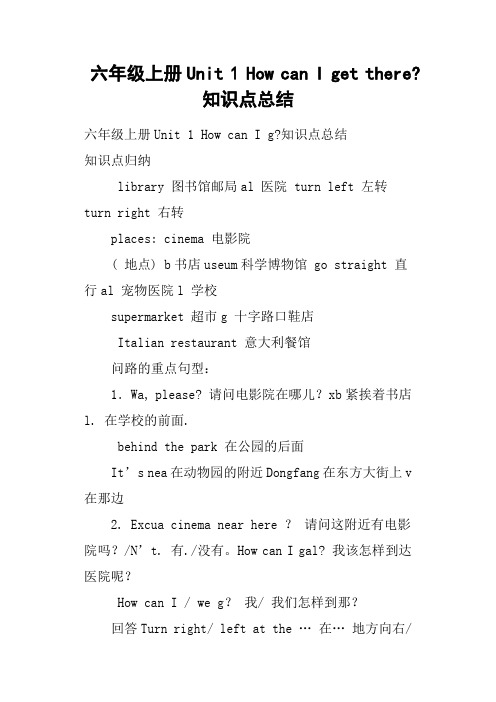
六年级上册Unit 1 How can I get there?知识点总结六年级上册Unit 1 How can I g?知识点总结知识点归纳library 图书馆邮局al 医院 turn left 左转turn right 右转places: cinema 电影院( 地点) b书店useum科学博物馆 go straight 直行al 宠物医院l 学校supermarket 超市g 十字路口鞋店Italian restaurant 意大利餐馆问路的重点句型:1.Wa, please? 请问电影院在哪儿?xb紧挨着书店l. 在学校的前面.behind the park 在公园的后面It’s nea在动物园的附近Dongfang在东方大街上v 在那边2. Excua cinema near here ?请问这附近有电影院吗?/N’t. 有./没有。
How can I gal? 我该怎样到达医院呢?How can I / we g?我/ 我们怎样到那?回答Turn right/ left at the … 在… 地方向右/左转.或Go straight 向前直走.或You can take the No.31 bus. 你可乘坐31路公交车去。
Is it fa? 离这儿远吗?/ N’t. 是的很远/ 不是很远。
Unit 2 Ways to gl一.知识点归纳(一)、词汇四会 bike ( 自行车) by ( 乘坐) slow down 慢下来bus (公共汽车) foot (脚) stop 停下ain (火车) how (怎样)plane ( 飞机) gl (上学)(轮船) taxi 出租车ferry 轮渡 sled 雪橇ubway ( 地铁) (交通工具前加by ,表示乘坐,但步行要用)(二)、重点句型① 询问交通方式用疑问代词how —— How do you go/l ? 你怎样去/来上学?—— I go/l我走路去/来上学。
六年级上册英语教案Unit1 How can I get there PA Let's learn∣人教版(PEP)()

Unit1 How can I get there?唐宋或更早之前,针对“经学”“律学”“算学”和“书学”各科目,其相应传授者称为“博士”,这与当今“博士”含义已经相去甚远。
而对那些特别讲授“武事”或讲解“经籍”者,又称“讲师”。
“教授”和“助教”均原为学官称谓。
前者始于宋,乃“宗学”“律学”“医学”“武学”等科目的讲授者;而后者则于西晋武帝时代即已设立了,主要协助国子、博士培养生徒。
“助教”在古代不仅要作入流的学问,其教书育人的职责也十分明晰。
唐代国子学、太学等所设之“助教”一席,也是当朝打眼的学官。
至明清两代,只设国子监(国子学)一科的“助教”,其身价不谓显赫,也称得上朝廷要员。
至此,无论是“博士”“讲师”,还是“教授”“助教”,其今日教师应具有的基本概念都具有了。
Part A Let’s learn(Page 5)单靠“死”记还不行,还得“活”用,姑且称之为“先死后活”吧。
让学生把一周看到或听到的新鲜事记下来,摒弃那些假话套话空话,写出自己的真情实感,篇幅可长可短,并要求运用积累的成语、名言警句等,定期检查点评,选择优秀篇目在班里朗读或展出。
这样,即巩固了所学的材料,又锻炼了学生的写作能力,同时还培养了学生的观察能力、思维能力等等,达到“一石多鸟”的效果。
教案这个工作可让学生分组负责收集整理,登在小黑板上,每周一换。
要求学生抽空抄录并且阅读成诵。
其目的在于扩大学生的知识面,引导学生关注社会,热爱生活,所以内容要尽量广泛一些,可以分为人生、价值、理想、学习、成长、责任、友谊、爱心、探索、环保等多方面。
如此下去,除假期外,一年便可以积累40多则材料。
如果学生的脑海里有了众多的鲜活生动的材料,写起文章来还用乱翻参考书吗? 教学目标1.语言技能:(1)能够听懂、会说、认读、默写五个表示“地点”的词汇:science museum, post office, bookstore, cinema, hospital, pet hospital.(2)能够正确使用句型“Where is the …? It’s next to / near the …”询问与答复有关地点所在的方位。
六年级上册英语教案Unit1HowcanIgetthere?BLetx27stalk_人教版PEP()
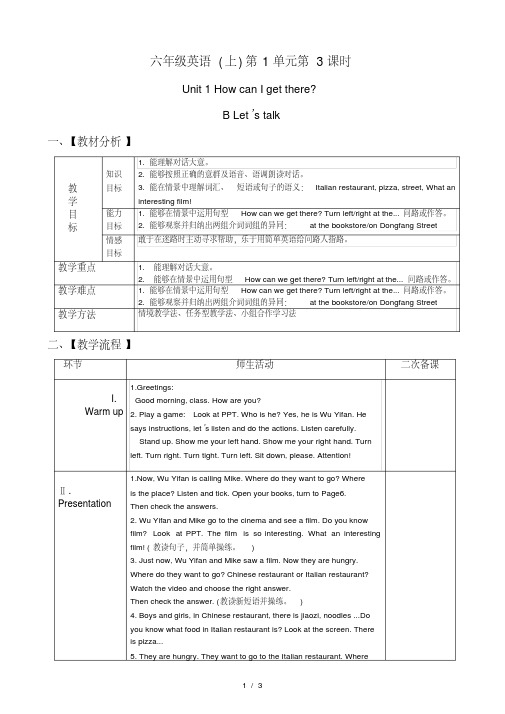
六年级英语(上)第1单元第3课时Unit 1 How can I get there?B Let’s talk一、【教材分析】教学目标知识目标1. 能理解对话大意。
2. 能够按照正确的意群及语音、语调朗读对话。
3. 能在情景中理解词汇、短语或句子的语义:Italian restaurant, pizza, street, What aninteresting film!能力目标1. 能够在情景中运用句型How can we get there? Turn left/right at the...问路或作答。
2. 能够观察并归纳出两组介词词组的异同:at the bookstore/on Dongfang Street情感目标敢于在迷路时主动寻求帮助,乐于用简单英语给问路人指路。
教学重点 1.能理解对话大意。
2.能够在情景中运用句型How can we get there? Turn left/right at the...问路或作答。
教学难点 1. 能够在情景中运用句型How can we get there? Turn left/right at the...问路或作答。
2. 能够观察并归纳出两组介词词组的异同:at the bookstore/on Dongfang Street教学方法情境教学法、任务型教学法、小组合作学习法二、【教学流程】环节师生活动二次备课I. Warm up 1.Greetings:Good morning, class. How are you?2. Play a game: Look at PPT. Who is he? Yes, he is Wu Yifan. He says instructions, let’s listen and do the actions. Listen carefully.Stand up. Show me your left hand. Show me your right hand. Turn left. Turn right. Turn tight. Turn left. Sit down, please. Attention!Ⅱ. Presentation 1.Now, Wu Yifan is calling Mike. Where do they want to go? Whereis the place? Listen and tick. Open your books, turn to Page6.Then check the answers.2. Wu Yifan and Mike go to the cinema and see a film. Do you know film? Look at PPT. The film is so interesting. What an interesting film! (教读句子,并简单操练。
人教版六年级上册英语第一单元Unit1《How can I get there?》重要知识点总结

【精选】人教pep版六年级上册英语第一单元Unit1《How can I get there?》重要知识点总结Unit1 How can I get there?一、重点单词和短语Science科学museum博物馆post office邮局bookstore书店cinema电影院hospital医院tasty美味的,可口的London Eye伦敦眼stomach胃crossing十字路口turn left/turn right向左/右转go straight=walk straight直走next to紧挨着/与……相邻far from(离……远)near在……附近behind(在……后面)in front of(在……前面)between…and…(在…和…之间)二、重点句子1.How do you go to school? 你是怎样去上学的?2.where is the restaurant? 餐馆在哪里?3. Usually I go to school on foot. 我通常走路去上学。
4. Sometimes I go by bike. 有时候我骑自行车去。
5.问路之前,出于礼貌,我们要说“Excuse me”与后面的句子要用标点符号隔开。
6.Look at the traffic lights, remember the traffic rules. 看着交通灯,记住交通规则。
7.Stop at a red light.Wait at a yellow light. Go at a green light.红灯停。
黄灯等一等。
绿灯行。
8.Red means stop, yellow means wait, green means go. 红色的意思是停止,黄色的意思是等待,绿色的意思是通行。
9.How can I get to the park? 我该怎样到达公园呢?10.You can go by the No.15 bus. 你可以坐15路公交车去。
最新pep人教版六年级英语上册Unit 1 How can I get there 知识点总结

最新pep人教版六年级英语上册知识点总结Unit 1How can I get there?单词:science 科学museum博物馆post office 邮局bookstore书店cinema电影院hospital医院crossing十字路口turn 转弯left向左ask 问interesting 有趣的Italian 意大利restaurant 餐馆pizza 比萨饼street 大街;街道get 到达GPS 全球卫星定位系统feature 特点follow 跟着far 较远的tell 告诉短语:turn left向左转turn right 向右转go straight直行in front of...在...前面next to挨着go straight直走near the park在公园附近on Dongfang Street在东方大街上post office邮局pet hospital宠物医院Beihai Park北海公园Italian restaurant意大利餐馆Palace Museum故宫博物院science museum科学博物馆句子:1、Where is the museum shop? 博物馆的商店在哪儿?2、It’s near the door. 在大门附近。
3、How can we get there? 我们怎么到那儿?4、Turn left at the bookstore. 在书店左转。
5、I want to buy a postcard. 我想买一张明信片。
6、I’ll ask. 我去问问。
7、Wow, a talking robot! 哇!一个讲话机器人。
8、What a great museum! 好棒的一家博物馆!10、There is a pet hospital in my city. 在我的城市有一家宠物医院。
11、Wu Yifan and Robin are looking at some robots. 吴一凡和罗宾正在看一些机器人。
人教PEP版六年级英语上册Unit-1《How-can-I-get-there》说课稿
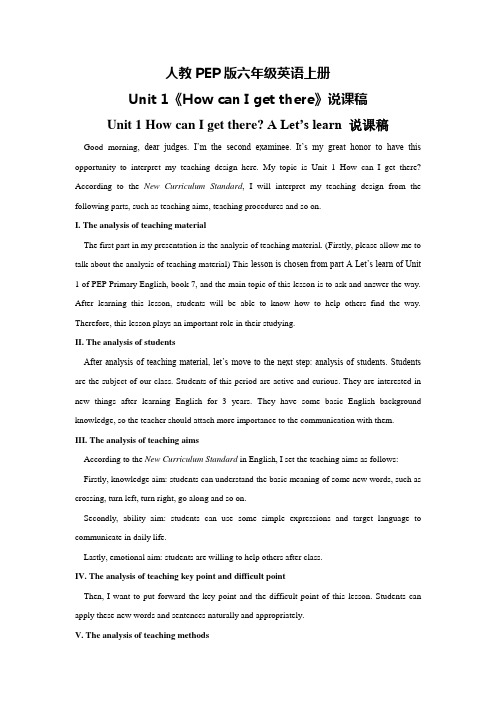
人教PEP版六年级英语上册Unit 1《How can I get there》说课稿Unit 1 How can I get there? A Let’s learn说课稿Good morning, dear judges. I’m the second examinee. It’s my great honor to have this opportunity to interpret my teaching design here. My topic is Unit 1 How can I get there? According to the New Curriculum Standard, I will interpret my teaching design from the following parts, such as teaching aims, teaching procedures and so on.I. The analysis of teaching materialThe first part in my presentation is the analysis of teaching material. (Firstly, please allow me to talk about the analysis of teaching material) This lesson is chosen from part A Let’s learn of Unit 1 of PEP Primary English, book 7, and the main topic of this lesson is to ask and answer the way. After learning this lesson, students will be able to know how to help others find the way. Therefore, this lesson plays an important role in their studying.II. The analysis of studentsAfter analysis of teaching material, let’s move to the next step: analysis of students. Students are the subject of our class. Students of this period are active and curious. They are interested in new things after learning English for 3 years. They have some basic English background knowledge, so the teacher should attach more importance to the communication with them.III. The analysis of teaching aimsAccording to the New Curriculum Standard in English, I set the teaching aims as follows: Firstly, knowledge aim: students can understand the basic meaning of some new words, such as crossing, turn left, turn right, go along and so on.Secondly, ability aim: students can use some simple expressions and target language to communicate in daily life.Lastly, emotional aim: students are willing to help others after class.IV. The analysis of teaching key point and difficult pointThen, I want to put forward the key point and the difficult point of this lesson. Students can apply these new words and sentences naturally and appropriately.V. The analysis of teaching methodsNow I want to talk about the teaching methods. Communicative Approach, Tasked-based Teaching Method and TPR Teaching Method will be adopted in this lesson to active my students. VI. The analysis of teaching aidsTo help students learn better. I will mainly use pictures and tape recorder as teaching aids. VII. The analysis of teaching procedureNext, let’s focus on the most important part of this lesson, the analysis of teaching procedures. It consists of the following steps: warming-up, pre-listening, while-listening, post-listening, summary and homework.Now, let’s go to the first step,warming-up. In this step, I will divide students into groups Monkey 1 and Monkey 2, the one who gets banana first is the winner. Then I will sing a song named penguin’s Game. After listening, students should tell me what they have heard in this song. Then I will tell students this song is about directions. This song is closed related to the topic of this lesson. Besides, It’s very interesting for students. They would be very glad to pay attention to this lesson.Then, let’s come to the second step, pre-listening. I will draw a map and some buildings on the blackboard. Imagine I’m a foreigner and get lost. Let students help me find my way. Then I will show them some new words such as, turn left, turn right, crossing and go straight through many actions. And a word game will be arranged. It’s a bomb game. If I say a word, students should read after me quickly. But when I read the boom word, students should be quiet. Through this activity, students will be attracted and know how to read and use the new words.Now let’s talk about next period, while-listening. There are 3 activities in this step. The first activity is extensive listening. I’ll ask students to listen to the tape, then find out the main idea of this conversation. The second activity is intensive listening. I will ask students to listen to the tape once again. And try to find the answer, “Where is the Italian restaurant?” The third activity is to read. Students should read after the tape and pay attention to their pronunciation. Through this section, students could develop the ability of grasp detailed information and cooperation spirit. They will join more class activities actively.Next step is post-listening. Some students will be asked to come the front of the class, and do some actions. The other students will guess the meaning of these new words. Then I will pick one place in the map like bookstore. Ask students “Where’ the bookstore?” Students will tell me theway in their own words according to the map. Role play is very attractive for students. Students would like to take part in it very actively. By this, students can improve their speaking skills and understand how to use these sentences to communicate with others.Now, let’s move on to the summary and homework. At the end of the class, I’ll make a summary together with students. The purpose of this step is to help students recall what we have learned today. And deepen their impression of the key words and sentences. The homework is to be a guide. Tell their friends the way to the house with the target language. Next class, I’ll invite some students to share it. It can develop their independent learning ability and provide more opportunities to practice after class. At last, I will attract students attention and tell students the winner of this class.VIII. The analysis of blackboard designThe last part is my blackboard design. These are the new words and phrases. These are key sentences. It’s very clear and simple for students. And the pictures can attract students attention. That’s all for my presentation. Thank you for your listening.。
人教PEP版英语六上Unit1《HowcanIgetthere》(Alet'sltalk)教学设计
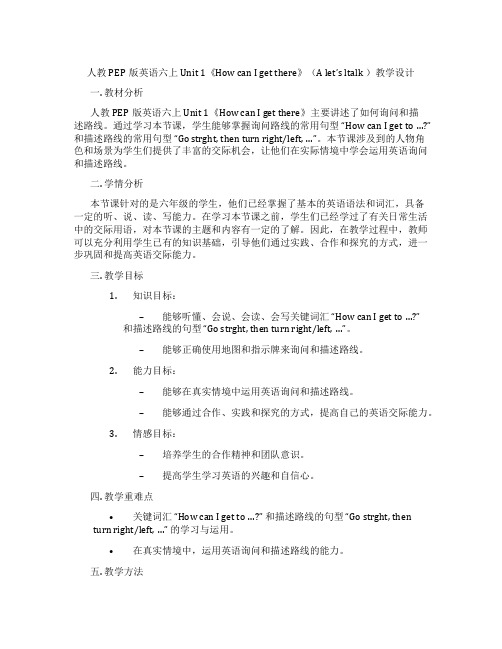
人教PEP版英语六上Unit 1《How can I get there》(A let’s ltalk )教学设计一. 教材分析人教PEP版英语六上Unit 1《How can I get there》主要讲述了如何询问和描述路线。
通过学习本节课,学生能够掌握询问路线的常用句型“How can I get to …?” 和描述路线的常用句型“Go strght, then turn right/left, …”。
本节课涉及到的人物角色和场景为学生们提供了丰富的交际机会,让他们在实际情境中学会运用英语询问和描述路线。
二. 学情分析本节课针对的是六年级的学生,他们已经掌握了基本的英语语法和词汇,具备一定的听、说、读、写能力。
在学习本节课之前,学生们已经学过了有关日常生活中的交际用语,对本节课的主题和内容有一定的了解。
因此,在教学过程中,教师可以充分利用学生已有的知识基础,引导他们通过实践、合作和探究的方式,进一步巩固和提高英语交际能力。
三. 教学目标1.知识目标:–能够听懂、会说、会读、会写关键词汇“How can I get to …?”和描述路线的句型“Go strght, then turn right/left, …”。
–能够正确使用地图和指示牌来询问和描述路线。
2.能力目标:–能够在真实情境中运用英语询问和描述路线。
–能够通过合作、实践和探究的方式,提高自己的英语交际能力。
3.情感目标:–培养学生的合作精神和团队意识。
–提高学生学习英语的兴趣和自信心。
四. 教学重难点•关键词汇“How can I get to …?” 和描述路线的句型“Go strght, then turn right/lef t, …” 的学习与运用。
•在真实情境中,运用英语询问和描述路线的能力。
五. 教学方法1.任务型教学法:通过设置具有实际意义和挑战性的任务,激发学生的学习兴趣,培养他们的合作精神和团队意识。
2.情境教学法:创设真实的语境,让学生在实际情境中学习、实践和运用英语。
Unit1HowcanIgetthere知识点整合(素材)人教PEP版英语六年级上册
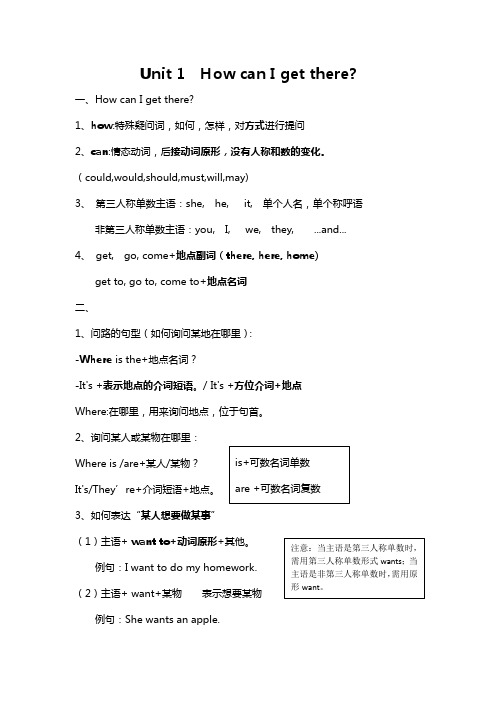
Unit 1 How can I get there?一、How can I get there?1、how :特殊疑问词,如何,怎样,对方式进行提问2、can :情态动词,后接动词原形,没有人称和数的变化。
(could,would,should,must,will,may)3、 第三人称单数主语:she, he, it, 单个人名,单个称呼语 非第三人称单数主语:you, I, we, they, ...and...4、 get, go, come+地点副词(there, here, home)get to, go to, come to+地点名词二、1、问路的句型(如何询问某地在哪里):-Where is the+地点名词?-It's +表示地点的介词短语。
/ It's +方位介词+地点Where:在哪里,用来询问地点,位于句首。
2、询问某人或某物在哪里:Where is /are+某人/某物?It's/They ’re+介词短语+地点。
3、如何表达“某人想要做某事”(1)主语+ want to+动词原形+其他。
例句:I want to do my homework.(2)主语+ want+某物 表示想要某物例句:She wants an apple.4、know(1)表达“知道”I don’t know Miss Feng is my English teacher.(2)表示“懂得”I know some English.(3)表示“认识”I know her for 5 years.5、区别Excuse me&sorry的用法(1)“Excuse me”意为“对不起;打扰(一下)”。
当我们需要麻烦别人或是打扰别人,比如问路、询问情况、表示异议等时,应该先说“Excuse me”,再说出自己的问题。
(2)“I'm sorry”也表示“对不起”,但是它用于犯了错误或不能为别人提供帮助时表示歉意。
六年级英语上册Unit1HowcanIgetthere单元知识小结人教PEP版

单词
science科学museum博物馆bookstore书店
cinema电影院hospital医院crossing十字路口
turn转弯left左straiost office邮局get to到达turn left左转
2. —How can I get there?我怎么到那儿?
—Turn right at the school. Then go straight.在学校右转。然后直走。
3. I want to buy a postcard.我想买一张明信片。
4. There is a pet hospital in my city.在我的城市里有一家宠物医院。
—Where is the hospital?医院在哪儿?
—It’s next to the post office.它靠近邮局。
句型
1.用句型“How can I/we get to +(the)地点名词?”来询问如何到达某地。其中“How”用来询问事情的方式,位于句首,引导特殊疑问句。
如:How can I get to the park?我怎么才能到达公园?
2.询问地点的固定句型为:Where+ be动词+地点/处所?答语通常为:It’s/They’re+地点。在口语中也可以直接用表示地点的介词短语来回答。如:
turn right右转next to靠近go straight直走
in front of在……前面over there在那儿
pass by经过far from离……远
句子
1. —Where is the science museum?科学博物馆在哪儿?
Unit1HowcanIgetthere?PartBLet’stalkLet’stry
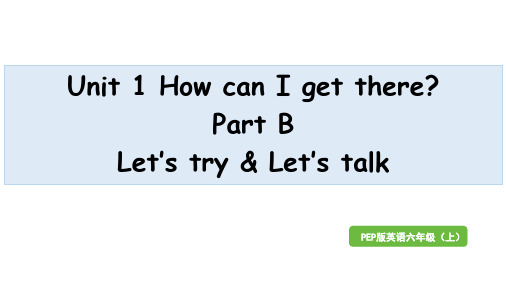
post office
hospital
Turn right at the post office, Then
go straight. It’s on the right.
bookstore
cinema
library
Exercises
一、圈出不同类的单词。
A. restaurant
B. hospital
I like... How can I get to the...?
Turn left/right at…
Activity 1
Role-play 角色扮演
bookstore restaurant
Activity 1
Role-play 角色扮演
A: Where is the …? B: It’s next to… on… Street. A: How can we get there? B: Turn left /right at the… Then turn
left/ right at …
Activity 2
How can I get to the post office?
bookstore
cinema
post office
Turn left at the cinema, then go straight. It’s on the left.
school
1. right, the, bookstore, turn, at (.)
Turn right at the bookstore. 2. an, interesting, what, film (!)
What an interesting film! 3. I, get, How, can, there (?)
人教版六年级英语上册《Unit 1 How can I get there》重点难点知识梳理

人教版六年级英语上册《Unit 1 How can I getthere?》重点难点知识梳理重点:询问某地在哪里的问句及其答语询问怎样到某地的句型动词want的用法难点:能够问路并描述路线Wha引导的感叹句四会单词短语science科学museum博物馆bookstore书店cinema电影院hospital医院crossing十字路口tumn转弯left左straight笔直地right右post office邮局三会单词短语ask问sir(对男子的礼貌称呼)先生interesting有趣的Italian意大利的restaurant餐馆pizza比萨饼street大街;街道get到达GPS全球(卫星)定位系统gave(give的过去式)提供;交给feature特点follow跟着far较远的tell告诉get to到达in front of…在……前面惯用表达式1.Excuse me.打扰了。
2.I don't know.我不知道。
3.Follow me,please!请跟着我!重点句式或句型1.- Robin,where is the museum shop?罗宾,博物馆的商店在哪儿?-It's near the door.它在大门附近。
解读:这是询问某地在哪里的问句及其答语。
句型结构:问句:Where is+地点(the bookstore,your school…)?答语:It's+表示地点的词语(near the park,over there,next to the school…).2.- How can we get there?我们怎么能到达那儿?-Turn left at thebookstore. Then turn right at the hospital到书店左转。
然后到医院右转。
解读:这是询问怎样到某地的问句及其答语。
句型结构:How can+主语+get(to)+地点?3.表示到某地向左转/向右转的句型Turn left /right at+地点.了解句型1.I want to buy a postcard.我想要买一张明信片。
Unit1howcanIgetthere知识详解(知识清单)人教PEP版英语六年级上册

Unit 1 知识详解Part A知识详解1.where 教你来问路解析:where 意为“在哪儿”,用来询问地点,位于句首。
当句型的主语是第三人称单数时,be动词要用is;当主语是复数时,be动词要用are.回答时经常会用到一些指路的短语,如:go ahead 往前走, turn right 右转, turn left左转。
也经常用到表示位置的单词或短语,如:beside 在旁边,next to 紧挨着,behind 在……后面, in front of 在……前面。
句型结构:“Where + is/are + 主语?”……在哪儿?例句:—Where are they? 它们在哪儿?—They are on the desk.它们在桌子上。
拓展:除了用 where 问路以外,还可以用下面的句子:Which is the way to...? 哪条路是去……的路?How can I get to the…? 我怎样才能到……?Can you tell me the way to…? 能告诉我怎样去……吗?2.用 How 询问如何到达某地原句呈现:How can I get there? 我怎样能到那儿呢?解析:How 意为“怎样”,用来询问做事情的方式,位于句首,引导特殊疑问句。
它的回答通常如下:① Turn right/left./Go straight./It's over there.等。
② On foot./By bike./By plane.这种回答是问句在特指主语乘坐何种交通方式到达的答语。
句型结构:How can + 主语 + get + 地点名词?例句:How can she get the bookstore?她怎样能到达书店呢?Turn left, then go straight.向左转,然后直走。
拓展:a. how old“多大”,用来询问年龄。
b. how much“多少”,用来询问不可数名词的数量或某物价钱。
Unit 1 How can I get there?(知识点复习)人教PEP版英语六年级上册
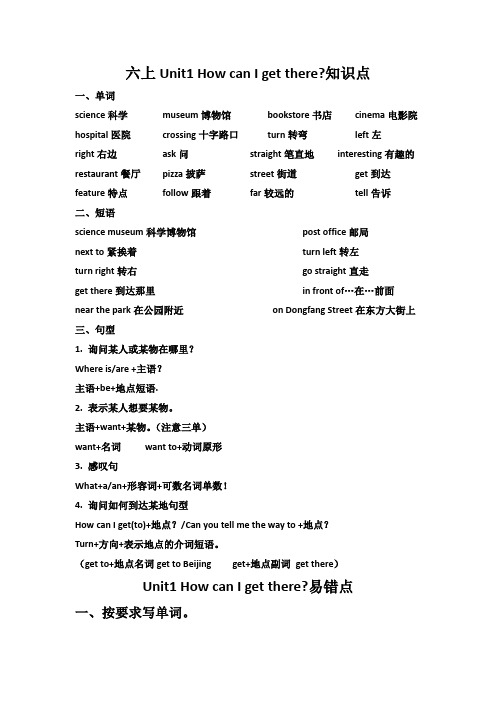
六上Unit1 How can I get there?知识点一、单词science科学museum博物馆bookstore书店cinema电影院hospital医院crossing十字路口turn转弯left左right右边ask问straight笔直地interesting有趣的restaurant餐厅pizza披萨street街道get到达feature特点follow跟着far较远的tell告诉二、短语science museum科学博物馆post office邮局next to紧挨着turn left转左turn right转右go straight直走get there到达那里in front of…在…前面near the park在公园附近on Dongfang Street在东方大街上三、句型1.询问某人或某物在哪里?Where is/are +主语?主语+be+地点短语.2.表示某人想要某物。
主语+want+某物。
(注意三单)want+名词want to+动词原形3.感叹句What+a/an+形容词+可数名词单数!4.询问如何到达某地句型How can I get(to)+地点?/Can you tell me the way to +地点?Turn+方向+表示地点的介词短语。
(get to+地点名词get to Beijing get+地点副词get there)Unit1 How can I get there?易错点一、按要求写单词。
1.Know(同音词)2.by(同音词)3.she(宾格)4.let’s(完全形式)5.left(反义词)6.there(对应词)6.tooth(复数)8.has(原形)9.can not(缩写形式)10.wash(三单)二、选择题。
()1.How much is the ?A.breadB.meatsC.potatoesD.tomatoes()2.The boy often English by .A.learns,readB.learn,readsC.learns,reading()3.We can get there tomorrow.A.toB.atC./()4.My mum often comes and the apples. A.picking B.pick C.picks()5.He to bed at nine.A.doesn’t often goB.often doesn’t goB.not often go D.go often三、用所给单词的适当形式填空。
六年级上册英语素材Unit1HowcanIgetthere知识详解人教
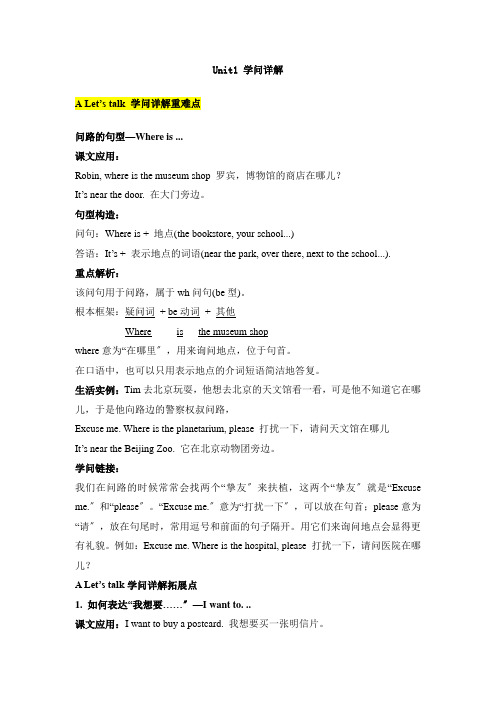
Unit1 学问详解A Let’s talk 学问详解重难点问路的句型—Where is ...课文应用:Robin, where is the museum shop 罗宾,博物馆的商店在哪儿?It’s near the door. 在大门旁边。
句型构造:问句:Where is + 地点(the bookstore, your school...)答语:It’s + 表示地点的词语(near the park, over there, next to the school...).重点解析:该问句用于问路,属于wh问句(be型)。
根本框架:疑问词+ be动词+ 其他Where is the museum shopwhere意为“在哪里〞,用来询问地点,位于句首。
在口语中,也可以只用表示地点的介词短语简洁地答复。
生活实例:Tim去北京玩耍,他想去北京的天文馆看一看,可是他不知道它在哪儿,于是他向路边的警察权叔问路,Excuse me. Where is the planetarium, please 打扰一下,请问天文馆在哪儿It’s near the Beijing Zoo. 它在北京动物团旁边。
学问链接:我们在问路的时候常常会找两个“挚友〞来扶植,这两个“挚友〞就是“Excuse me.〞和“please〞。
“Excuse me.〞意为“打扰一下〞,可以放在句首;please意为“请〞,放在句尾时,常用逗号和前面的句子隔开。
用它们来询问地点会显得更有礼貌。
例如:Excuse me. Where is the hospital, please 打扰一下,请问医院在哪儿?A Let’s talk学问详解拓展点1. 如何表达“我想要……〞—I want to. ..课文应用:I want to buy a postcard. 我想要买一张明信片。
句型构造:I want to + 动词原形+ 其他.重点解析:此句型用于表达自己想要做某事,这是一个一般如今时的句子。
【最新】人教版六年级上册Unit 1 How can I get there精品教案单元教案 一
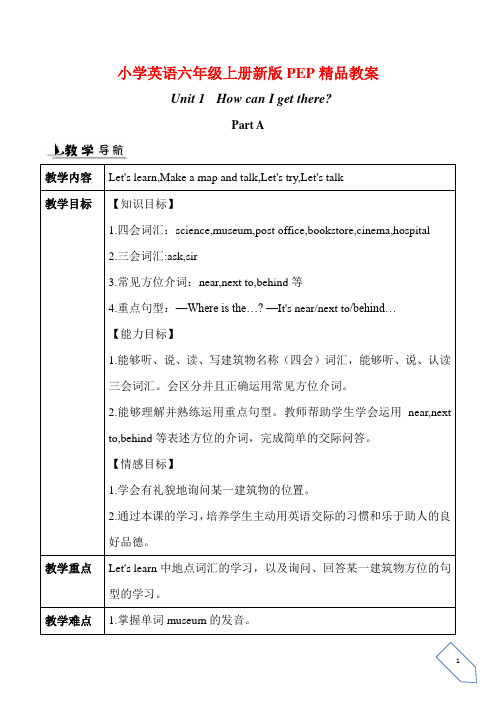
小学英语六年级上册新版PEP精品教案Unit 1 How can I get there?Part A教学内容Let's learn,Make a map and talk,Let's try,Let's talk教学目标【知识目标】1.四会词汇:science,museum,post office,bookstore,cinema,hospital2.三会词汇:ask,sir3.常见方位介词:near,next to,behind等4.重点句型:—Where is the…?—It's near/next to/behind…【能力目标】1.能够听、说、读、写建筑物名称(四会)词汇,能够听、说、认读三会词汇。
会区分并且正确运用常见方位介词。
2.能够理解并熟练运用重点句型。
教师帮助学生学会运用near,nextto,behind等表述方位的介词,完成简单的交际问答。
【情感目标】1.学会有礼貌地询问某一建筑物的位置。
2.通过本课的学习,培养学生主动用英语交际的习惯和乐于助人的良好品德。
教学重点Let's learn中地点词汇的学习,以及询问、回答某一建筑物方位的句型的学习。
教学难点 1.掌握单词museum的发音。
2.常见方位介词意义和用法的区分。
教学准备课件、录音机、磁带(或其他音频播放设备)、一本书、教学图片若干、一张明信片、地图等课时安排2课时第一课时教学过程批注一、Warm-up & Revision师生自由问答。
T:Good morning,everyone!Ss:Good morning,Miss Wang!T:What's the weather like today?Ss:It's sunny!T:Good!What's this in English?(教师拿出一本书)Ss:It's a book.T:Yes,it's my book.Where can we buy books?(教师出示书店图片)Ss:In the bookstore.“T”代表教师,“Ss”代表全班学生,后同。
新人教(PEP)六年级英语上册Unit 1 How can I get there 知识详解
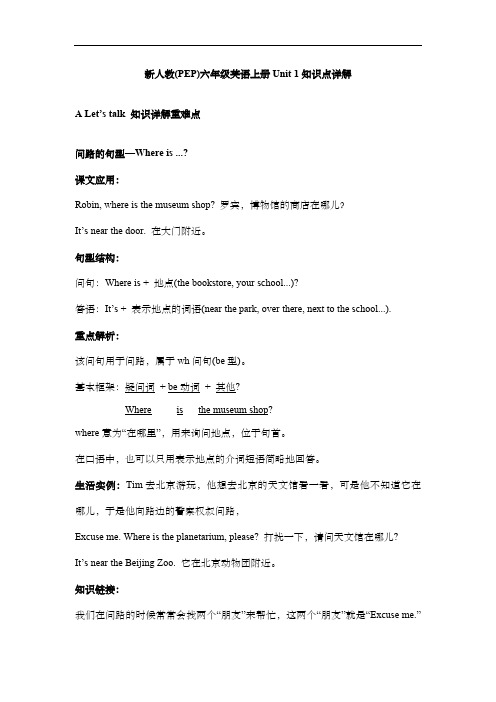
新人教(PEP)六年级英语上册Unit 1知识点详解A Let’s talk 知识详解重难点问路的句型—Where is ...?课文应用:Robin, where is the museum shop? 罗宾,博物馆的商店在哪儿?It’s near the door. 在大门附近。
句型结构:问句:Where is + 地点(the bookstore, your school...)?答语:It’s + 表示地点的词语(near the park, over there, next to the school...).重点解析:该问句用于问路,属于wh问句(be型)。
基本框架:疑问词+ be动词+ 其他?Where is the museum shop?where意为“在哪里”,用来询问地点,位于句首。
在口语中,也可以只用表示地点的介词短语简略地回答。
生活实例:Tim去北京游玩,他想去北京的天文馆看一看,可是他不知道它在哪儿,于是他向路边的警察权叔问路,Excuse me. Where is the planetarium, please? 打扰一下,请问天文馆在哪儿?It’s near the Beijing Zoo. 它在北京动物团附近。
知识链接:我们在问路的时候常常会找两个“朋友”来帮忙,这两个“朋友”就是“Excuse me.”和“please”。
“Excuse me.”意为“打扰一下”,可以放在句首;please意为“请”,放在句尾时,常用逗号和前面的句子隔开。
用它们来询问地点会显得更有礼貌。
例如:Excuse me. Where is the hospital, please? 打扰一下,请问医院在哪儿?A Let’s talk知识详解拓展点1. 如何表达“我想要……”—I want to. ..课文应用:I want to buy a postcard. 我想要买一张明信片。
句型结构:I want to + 动词原形+ 其他.重点解析:此句型用于表达自己想要做某事,这是一个一般现在时的句子。
《教学解析》-2020新版六年级上册Unit1-How-can-I-get-there-A-let's-learn第二课时

Where is the science museum ?
It’s next to the cinema.
The science museum is next to the cinema.
A talking robot ! Let’ s go to the museum and have a look !
science museum
What a great museum! Robin: Where is the post office? Man: It’s next to the museum. Robin: Thanks.
Where is the…? bookstore
hospital cinema library post office
science museum. Where is the science museum?
Where is the cinema? It’s near the library.
The cinema is ne is the post office? It’s behind the hospital.
Unit 1 How can I get there?
A Let’s talk
Let’s sing!
Where is the hospital? Where is the hospital? Is it near the park? Where is the cinema? Is it near the mall? Come to the bookstore. It’s next to the light. Come with me! Come with me ! Come with me tonight !
- 1、下载文档前请自行甄别文档内容的完整性,平台不提供额外的编辑、内容补充、找答案等附加服务。
- 2、"仅部分预览"的文档,不可在线预览部分如存在完整性等问题,可反馈申请退款(可完整预览的文档不适用该条件!)。
- 3、如文档侵犯您的权益,请联系客服反馈,我们会尽快为您处理(人工客服工作时间:9:00-18:30)。
设计意图:通过自主设计,进一步运用本次课的重点。
设计理念与特色:
通过内容的层层递进,设计具体有趣的任务,把抽象的内容视觉化、具体化,让学生更好地感知、理解in front of, between, behind, near, next to并在一系列的情境活动中进行运用。本课适合学生在阅读课文后进行复习。通过学习与操练,让学生在课后对知识进行归纳与总结。
能在情境中准确的运用in front of, between, behind, near, next to来描述物体的方位。
教学资源与环境:
PPT课件
教学过程:
1、引出主题:Hi, friends. Do you like the TV program“Dad, where are we going?”And they come to Dongguan this time.
微课教学设计方案
《六上Unit 1 How can I get there A Let's talk课后介词用法》
微课基本信息
知识点名称:
六上Unit 1 How can I get there A Let's talk课后介词用法
学科类型与教学对象:
小学英语六年级
预计上课时间长度:
8分钟
教学目标:
设计意图:具体的任务,找位置,描述位置,使得活动有趣,有效。
3、Task 2: Find out the pictures in the Science Museum and describe them.
在博物馆里藏着一些图片,孩子们只要找到一张图片并描述出图片内容就算完成任务。
设计意图:在活动中操练,使孩子能在情境中运用所学知识。
微点评:(说明:如没有专家点评,可邀请科组老师进行点评。)
该微课较为知识性的总结与归纳,并能很好地操练和运用in front of, between, behind, near, next to,虽然较为简单,但这样可以照顾到基础较差的学生在里方式:
讲解与演示相结合。
微反思:
本微课创设了有效的情境,将知识融合在电视剧“Dad, where are we going?”的主线中,体现简单的交互交际功能。这种设计符合学生心理年龄特征及语言习得一般规律,迎合了学生的需求,让他们在轻松的环境中学习、复习。
从实施的反馈来看,该微课可以作为学生课后的复习材料,也可以作为课堂上演示的课件;观看微课之后,学生基本上掌握了in front of, between, behind, near, next to的简单运用。
设计意图:创建情境,让学生在轻松、喜爱的环境中展开新内容。
2、Task 1: Find out the places on the map.
A:在地图上找到相应该的位置。
B:清楚描述每个地方的具体位置。
C:利用图片学习in front of, between, behind, near, next to
